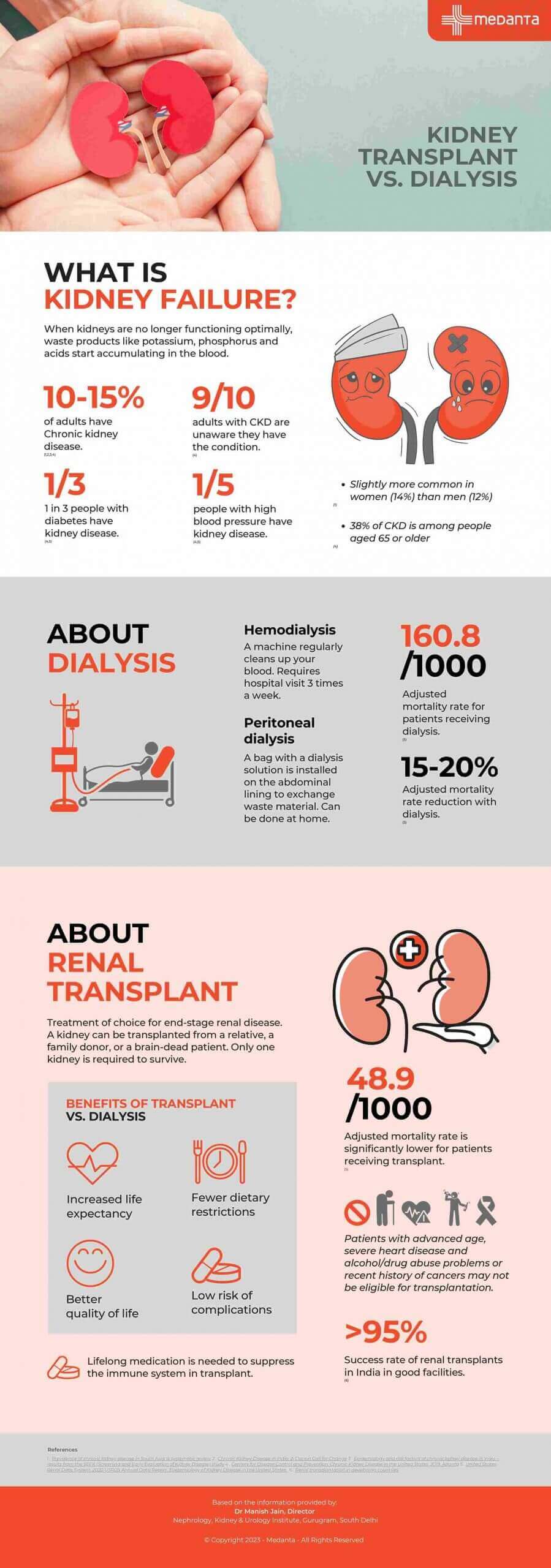Kidney Transplant Vs Dialysis

Kidney failure, or end-stage renal disease, is a serious medical condition that requires prompt treatment. Dialysis and renal transplant are the two main treatment options for ESRD. While dialysis can help manage the symptoms of ESRD, renal transplant is the preferred treatment option for many patients.
Kidney failure, or end-stage renal disease (ESRD), is a serious medical condition that occurs when the kidneys can no longer effectively filter waste and excess fluids from the blood. The prevalence of chronic kidney disease (CKD), which is a precursor to ESRD, is estimated to be around 10-15% of adults, and many individuals with CKD are unaware of their condition.
Some scary facts about kidney disease are
- 1 in 3 people with diabetes have kidney disease.
- 9/10 adults with CKD are unaware they have the condition.
- 1/5 people with high blood pressure have kidney disease.
- Slightly more common in women (14%) than men (12%)
- 38% of CKD is among people aged 65 or older
There are several risk factors for CKD, including diabetes and high blood pressure, which are also the leading causes of ESRD. Other risk factors include age, obesity, smoking, and a family history of kidney disease. Women are slightly more likely to develop CKD than men.
When end-stage renal disease occurs, there are two main treatment options: dialysis and renal transplant. Dialysis is a process that uses a machine or a solution placed in the abdomen to filter waste and excess fluids from the body. Hemodialysis requires patients to visit a hospital or dialysis center three times a week, while peritoneal dialysis can be done at home. Dialysis can reduce mortality rates by 15-20%, but the adjusted mortality rate for patients receiving dialysis is still high, at 160.8/1000.
Renal transplant involves transplanting a healthy kidney from a donor into a patient with ESRD. Renal transplant is considered the treatment of choice for ESRD and offers several benefits over dialysis. A kidney can be transplanted from a relative, a family donor, or a brain-dead patient, and only one kidney is required to survive.
One of the main benefits of renal transplant over dialysis is an increased life expectancy. Studies have shown that renal transplant recipients generally have a better long-term survival rate compared to dialysis patients. Renal transplant also offers fewer dietary restrictions and a better quality of life, as patients are no longer tied to a machine for several hours a week. In addition, the risk of complications is generally lower with renal transplant compared to dialysis.
It is important to note that renal transplant is not without risks. Patients who receive a kidney transplant must take immunosuppressive drugs for the rest of their lives to prevent rejection of the transplanted kidney. These drugs can have side effects, such as an increased risk of infections, high blood pressure, and diabetes. In addition, there is a shortage of available kidneys for transplant, which means that not all patients with ESRD are eligible for renal transplant.
In conclusion, kidney failure, or end-stage renal disease, is a serious medical condition that requires prompt treatment. Dialysis and renal transplant are the two main treatment options for ESRD. While dialysis can help manage the symptoms of ESRD, renal transplant is the preferred treatment option for many patients. Renal transplant offers several benefits over dialysis, including increased life expectancy, fewer dietary restrictions, a better quality of life, and a lower risk of complications. However, renal transplant is not without risks and requires lifelong immunosuppressive therapy. According to a report, Success rate of renal transplants in India in good facilities is more than 95%. It is important for patients with end-stage renal disease to work closely with their healthcare providers to determine the best treatment option for their individual needs.
References :
1 . Prevalence of chronic kidney disease in South Asia: a systematic review
2 . Chronic Kidney Disease in India: A Clarion Call for Change
3 . Epidemiology and risk factors of chronic kidney disease in India – results from the SEEK (Screening and Early Evaluation of Kidney Disease) study
6 . Renal transplantation in developing countries






